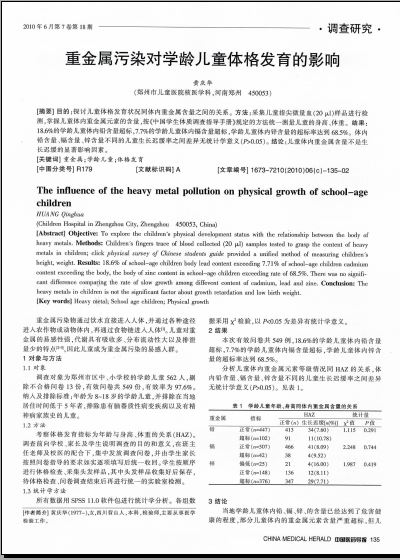重金属污染对学龄儿童体格发育的影响
 |
| 第1页 |
参见附件(1152KB,2页)。
[摘要] 目的:探讨儿童体格发育状况同体内重金属含量之间的关系。方法:采集儿童指尖微量血(20 μl)样品进行检测,掌握儿童体内重金属元素的含量,按《中国学生体质调查指导手册》规定的方法统一测量儿童的身高、体重。结果:18.6%的学龄儿童体内铅含量超标,7.7%的学龄儿童体内镉含量超标,学龄儿童体内锌含量的超标率达到68.5%。体内铅含量、镉含量、锌含量不同的儿童生长迟缓率之间差异无统计学意义(P>0.05)。结论:儿童体内重金属含量不是生长迟缓的显著影响因素。
[关键词] 重金属;学龄儿童;体格发育
[中图分类号] R179[文献标识码] A [文章编号] 1673-7210(2010)06(c)-135-02
The influence of the heavy metal pollution on physical growth of school-age children
HUANG Qinghua
(Children Hospital in Zhengzhou City, Zhengzhou 450053, China)
[Abstract] Objective: To explore the children's physical development status with the relationship between the body of heavy metals. Methods: Children's fingers trace of blood collected (20 μl) samples tested to grasp the content of heavy metals in children; click physical survey of Chinese students guide provided a unified method of measuring children's height, weight. Results: 18.6% of school-age children body lead content exceeding 7.71% of school-age children cadmium content exceeding the body, the body of zinc content in school-age children exceeding rate of 68.5%. There was no significant difference comparing the rate of slow growth among diffevent content of cadmium, lead and zine. Conclusion: The heavy metals in children is not the significant factor about growth retardation and low birth weight.
[Key words] Heavy metal; School age children; Physical growth
重金属污染物通过饮水直接进入人体,并通过各种途径进入农作物或动物体内,再通过食物链进入人体[1]。儿童对重金属的易感性强,代谢具有吸收多、分布流动性大以及排泄量少的特点[2-3],因此儿童成为重金属污染的易感人群。
1 对象与方法
1.1 对象
调查对象为郑州市区中、小学校的学龄儿童562人,剔除不合格问卷13份,有效问卷共549份,有效率为97.6%。纳入及排除标准:年龄为8~18岁的学龄儿童,并排除在当地居住时间低于5年者,排除患有脑器质性病变疾病以及有精神病家族史的儿童。
1.2 方法
考察体格发育指标为年龄与身高、体重的关系(HAZ)。调查前向学校、家长及学生说明调查的目的和意义,在班主任老师及校医的配合下,集中发放调查问卷,并由学生家长按照问卷指导的要求如实逐项填写后统一收回。学生按顺序进行体格检查、采集头发样品,其中头发样品收集好后保存,待体格检查、问卷调查结束后再进行统一的实验室检测。
1.3 统计学方法
所有数据用SPSS 11 ......
您现在查看是摘要介绍页,详见PDF附件(1152KB,2页)。